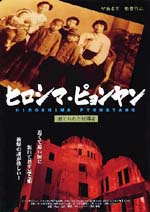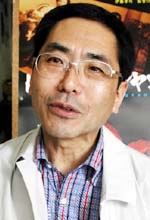"Hiroshima and Pyongyang" directed by Takashi Ito

|
"Hiroshima and Pyongyang" is a documentary film about an A-bomb survivor who lives in North Korea. The survivor, a woman named Lee Gyeseon, lives in the capital of North Korea, Pyongyang. According to her account, in August 1945, at the age of 3, she entered the city of Hiroshima with her mother in the aftermath of the atomic bombing and she was affected by her exposure to the bomb's radiation. The film conveys the anger and sorrow of an A-bomb survivor who has been neglected and cut off from the support available to other survivors, such as the Atomic Bomb Survivors Certificate, because North Korea does not have diplomatic relations with Japan. The film was completed in 2009 and runs 90 minutes. It has been screened in several places in Japan. In March 2010, a book about the film was published and a DVD of the film will be released in spring 2011. |
A-bomb survivors cut off from support
Film seeks to end discrimination

|
Takashi Ito
Born in 1952 in the city of Ina in Nagano Prefecture. A photojournalist, after publishing a book of his photographs about South Korean and North Korean A-bomb survivors, and organizing an exhibition of these images, he left his company to work freelance. He has covered war victims and environmental degradation in the Asia-Pacific region and transmits this work through magazines and on TV. He lives in Mie Prefecture.
The documentary film "Hiroshima and Pyongyang" follows the life of a woman who experienced the atomic bombing of Hiroshima and subsequently returned to live in North Korea. The director of the film, Takashi Ito, 58, sheds light on the problem of A-bomb survivors (hibakusha) in North Korea, which has no diplomatic relations with Japan, being cut off from support measures. I asked Mr. Ito for his thoughts about the film and he stressed: "Hibakusha are hibakusha no matter where they live. We mustn't abandon them, simply blaming it on the poor relationship between the two countries."
Mr. Ito went to Pyongyang from 2008 to 2009 to shoot the film. His subject, Lee Gyeseon, entered the city of Hiroshima in the aftermath of the atomic bombing and now suffers from skin disease, disease to her digestive organs, and anemia. She has not been able to obtain the Atomic Bomb Survivors Certificate. Mr. Ito hopes that the existence of A-bomb survivors who are cut off from support is a problem that will become more widely known.
Recently, it has become possible for survivors living overseas to obtain the Certificate, but those in North Korea are still unable to submit an application. As of the end of 2007, it is estimated that about 380 survivors reside in North Korea, and they are growing older. Mr. Ito appealed for support, saying, "Humanitarian aid is urgently needed."
He also includes North Korea's nuclear development program and a military parade in his film. He said, "I'm opposed to nuclear weapons. When I heard North Korean survivors say that nuclear weapons are needed to protect their nation, I found it disconcerting."
He incorporated other materials into the film to show the reality of the atomic bombing, such as photos of the A-bomb Dome in the aftermath of the blast and A-bomb pictures drawn by survivors. "I want young people who don't know much about the atomic bombs to see this film," Mr. Ito said. "I want to directly convey the inhumanity of the atomic bombs."
The impact of Ken Domon's work, a well-known photographer who portrayed the A-bomb experience of Hiroshima, led Mr. Ito to visit Hiroshima and Nagasaki in 1981. Two years later he came to know about the existence of Korean and North Korean A-bomb survivors. The fact shocked him since he had thought that the survivors of the bombings were all Japanese. "They have been suffering a 'double discrimination,'" Mr. Ito said. "The support for these people has been inadequate. By exposing this state of affairs, I want to show the truth and help end this discrimination." This quest has become his life's work.
His work has taken him to a number of nations in the Asia-Pacific region. Another of the subjects he has focused on is deforestation in Papua New Guinea. There he met local residents who live a happy, self-sufficient life in a primeval forest. "There are many cultures quite different from the culture of Japan. I want people to appreciate these differences. That will help us to build a world without conflict." Mr. Ito conveys this message to the children who will forge the future of our planet. (Sakiko Masuda, Staff Writer)
|